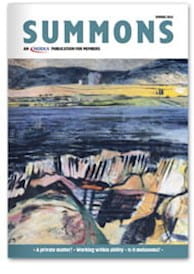ON the morning of August 7, 1967, a 15-year-old schoolgirl was found murdered in a small Scottish town. She had been beaten and strangled, and her right breast appeared to have a bite mark. If a single case can define a career, what was to become known as the Biggar murder would define that of Dr Warren Harvey.
Born in Staffordshire, Harvey was the elder son of a doctor. He was educated at Shrewsbury and then moved south to obtain his medical and dental degrees at Guy’s Hospital. He spent the war as a dental officer in the RAF and afterwards built a successful private dental practice in London, as well as being consultant dental surgeon to the Royal Masonic Hospital in Hammersmith. In 1962 he was diagnosed with the throat cancer that would force his early retirement two years later. He moved from the bustle of London to the Ayrshire coast, but his retirement was short-lived. Soon after moving to Scotland he was recruited by the Glasgow Dental Hospital as locum consultant and as lecturer in the Department of Dental Surgery at Glasgow University – posts he would hold for the next 10 years.
It was while working in Glasgow that he was asked to consult on the Biggar murder – a case which the judge would describe as “grave, serious and in some ways unique”. The victim, Linda Peacock, from the small Lanarkshire town of Biggar, had been assaulted in the town cemetery. Although she had not been raped there was clear evidence of a sexual motive for her attack – in particular the bite mark on her right breast was the most important clue. The bite, because of its shape, was obviously not that of an animal and could not have been self-inflicted because of its position. The investigating team quickly realised that the girl’s killer had left his dental “fingerprint” behind.
The close proximity to the murder scene of an approved school for juvenile convicts presented an obvious line of enquiry for the police. Some 29 inmates and staff were identified as suspects and dental impressions were taken of their teeth. These impressions were anonymised and Harvey and his colleagues studied them, excluding all but five suspects, who gave further impressions.
A single set – Number 11 – was consistent with the bruising on Linda Peacock’s breast. Only at this point was the code broken and Harvey informed that these were the impressions of 17-year-old Gordon Hay. Harvey sought a warrant to examine Hay’s teeth for a third time, which was granted by the sheriff.
The main evidence linking Hay with the murder was the unusual pattern of bruising associated with the bite mark – small, ring-shaped contusions with pale centres. Hay’s teeth showed signs of cuspal maldevelopment with a raised circular edge – exactly the pattern that might have caused the unusual bruises. But if the court was to be convinced of Hay’s guilt, Harvey would have to show that such a dental defect was uncommon. Harvey studied 1,000 canines in almost 350 boys aged 16-17 and found only two teeth with pits similar to those of Hay and none in opposing canines in the same mouth.
At the trial the following spring, Harvey presented this evidence along with detailed expert testimony on the links between Hay’s impressions and the bruising. He had spent over 400 hours preparing the case and would spend almost five hours in the witness box.
It took the jury just two and a half hours to find Hay guilty of murder and because he was under 18 he was not given a life sentence but ordered to be detained at Her Majesty’s pleasure.
This was the first case in Scotland where the Crown relied on forensic odontology and the first in the UK where a murder conviction was secured based on the characteristics of a bite mark. Forensic dentistry was not completely new to the courts but it was still contentious. In his instructions to the jury the judge counselled: “the law must keep pace with science…it usually lags a little behind but it does progress as scientific knowledge itself advances.”
Harvey’s continued ill-health finally forced him to retire properly in 1974 and he moved back close to his roots in the Welsh hills, where he died two years later.
His long-awaited textbook, Dental Identification and Forensic Odontology, was published just two weeks before his death. Unfortunately, he did not live to see it hailed as a classic, but his commitment to clinical research continued to the end and he bequeathed his body to medical research.
Despite being debilitated for 14 years by his cancer and its treatment, Harvey was able to develop and dominate a second career. He is rightly regarded as one of the founding fathers of forensic odontology in the UK and his work on the Biggar murder case as a watershed for that specialty.
Dr Allan Gaw is a clinical researcher and writer in Glasgow
Sources
- F.G McDonald
- Obituaries: The Probe July 1976 and British Dental Journal June 1976.
- Harvey W et al. The Biggar Murder. J Forensic Sci Soc. 1968; 8:157-219.
- Archives, University of Glasgow
This page was correct at the time of publication. Any guidance is intended as general guidance for members only. If you are a member and need specific advice relating to your own circumstances, please contact one of our advisers.
Read more from this issue of Insight

Save this article
Save this article to a list of favourite articles which members can access in their account.
Save to library